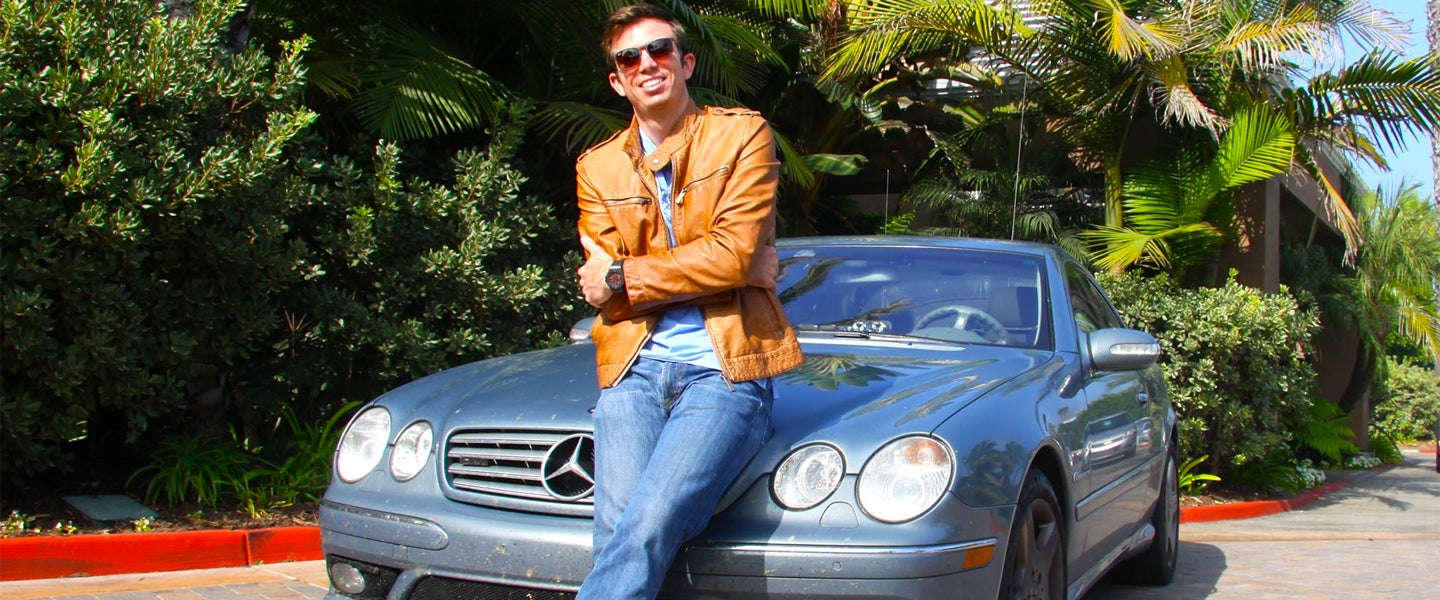At 18, Ed Bolian knew he wanted to set the record for fastest trip across the U.S. without getting a speeding ticket, or as the pursuit is officially known — the (highly illegal) Cannonball Run. It would take a decade of meticulous planning, saving and training for him to finally achieve that goal in 2013. According to Google, the trip takes at least 40 hours, but driving at an average speed of 98 miles per hour, Bolian, then 27, did it in 28 hours and 50 minutes.
Pulling into the parking lot of the Portofino Hotel in Redondo Beach, California, after driving 2,813.7 miles straight was undoubtedly one of Bolian’s proudest moments. But he says, “For me, it was a lot more about the destination to the starting line than the destination to the finish line.” (There were rumors that the previous record-holder, Alex Roy, had spent $500,000 chasing the record; Bolian, however, “spent about $45,000, which was every dollar I had.”)
As you can probably tell, Bolian lives and breathes the Cannonball Run. He can easily recount every previous record, who broke it and how they did so. Naturally, Edwin “Cannon Ball” Baker was the first. Per legend, in 1933, he drove from New York to L.A. in 53 hours and 30 minutes for unknown reasons. The drive was eventually picked up by Car and Driver contributor/race-car driver Brock Yates in 1971 as a way to protest increasingly strict traffic laws. The race was called The Cannonball Baker Sea-to-Shining Sea Memorial Trophy Dash.
Eight years later, the record was set at 32 hours and 7 minutes, where it remained until 2006, when Roy and Dave Maher beat it with a time of 31 hours and 4 minutes. Which stood until Bolian took the wheel in 2013 and bested it by roughly 2 hours and 15 minutes.
But now, thanks to the coronavirus, it’s seemingly being usurped on a daily basis. For pretty obvious reasons, too — the pandemic has completely cleared the country’s cities and highways of traffic, providing more open road than ever before. “It was the first weekend of quarantine where anybody was out trying it. That’s when the craziness began,” Bolian tells me. In fact, during the first five weeks of quarantine, the record was allegedly broken seven times.
Then came April 4th. “We knew of one run happening, but we later found out about another run, by someone we didn’t know, was also happening. That’s the one that set the record.” The mysterious driver reached out to Bolian with 500 miles left to go. “They realized that they had a chance at beating the record,” he says. “So we were able to watch through tracking software for their last stretch, and look at the metadata for stuff like when they left and confirm everything was in order.”
The new record hasn’t been disclosed exactly, but Bolian says it’s less than 26 hours, which means the driver would have had an average speed of at least 108 miles per hour for 2,801 miles.
“These guys were pretty whimsically able to go out and do it, while it took me a decade of planning — and I loved that decade of planning,” Bolian tells me. “Again, that was a really meaningful part of the pursuit for me. So did it carry the same meaning to them as it did to me?”
“Cannonball is kind of like a multivariable equation,” Bolian continues. “You have to solve when you want to leave, and when that puts you through each of the major cities that you want to avoid rush hour traffic in. Particularly in L.A., you want to get there in the middle of the night.”
Beyond timing, there’s also all the technology, or “countermeasures,” needed to avoid police detection, Bolian explains. In 2013, he had three radar detectors, two laser-jamming systems, four GPS systems, an ambulance traffic light changer, a police scanner, CB radio, multiple extra fuel tanks “and several tablets and phones to run programs like Waze.” Your choice of car obviously matters as well. It can’t be so fast and flashy that you draw the police’s attention, but it definitely needs to be “reliable and comfortable enough to survive it.”
Given all of this, in a video discussing the new records on his YouTube channel, Bolian wonders whether future Cannonball Run enthusiasts will view this period similar to the way baseball fans view the yoked-up 1990s with Sammy Sosa and Mark McGwire crushing record-setting home run after record-setting home run. That is to say, people are more concerned with breaking records than they are the spirit of the competition — which, notably, mostly only pays off in pride. (“There’s no trophy or money,” Bolian says. “It’s just one of those personal pursuits that’s easy to feel good about at the end.”)
Drivers who have raced during coronavirus and in normal traffic circumstances, “immediately realized the two were wildly different experiences,” Bolian explains. “So it’s one of those things that we’re recognizing, at the moment, in ways we can’t fully understand. It’s a very different challenge.”
In fairness, though, how do you impart laws on a competition that depends on being lawless in the first place?
“You can’t,” Bolian responds, “unless it destroys the pursuit.”
Or put more bluntly, if the sub-26-hour record is so fast that it’s impossible to achieve with current technology during non-COVID times, “then the window in which that was possible might warrant exclusion.”

